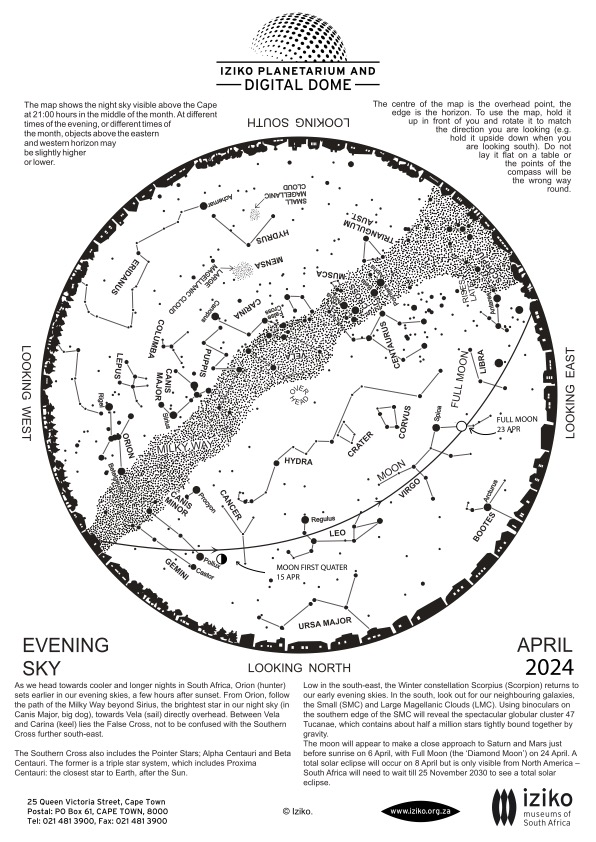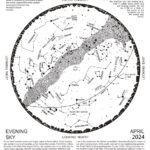
02 Apr Whats Up – April 2024
In a nutshell…
Moon
| Date | Time | Phase |
|---|---|---|
| 02/04 | 05h14 | Last Quarter |
| 08/04 | 20h20 | New Moon |
| 15/04 | 21h13 | First Quarter |
| 24/04 | 01h48 | Full Moon |
Moon – Earth Relations
Perigee: 358 850 km on 07/04 at 19h50
Apogee: 405 623 km on 20/04 at 04h10
Planet Visibility
Mercury is visible near the stars of the constellation Pisces in the morning sky at the very end of the month
Venus is not visible this month
Mars is visible near the stars of the constellation Aquarius at the beginning of the month and near the stars of the constellation Pisces at month end in the morning sky
Jupiter is not visible this month
Saturn is visible near the stars of the constellation Aquarius in the morning sky
Some easy to identify bright stars
Rigel: blue supergiant in Orion
Betelgeuse: red supergiant in Orion
Procyon: yellowish white star in Canis Minor
Sirius: brightest star in the night sky, located in Canis Major
Antares: red supergiant in Scorpius
Arcturus: red giant in Boötes
Spica: brightest bluish-white star in Virgo
Canopus: yellowish-white star in Carina
Altair: a white star, brightest in Aquila
Regulus: blue–white star and the brightest star in Leo
The Pointers: Alpha and Beta Centauri
Sun and Moon
The Last Quarter Moon falls on the 2nd of April at 05h14 and the New Moon occurs on the 8th of April at 20h20. The First Quarter Moon falls on the 15th of April at 21h13 and the Full Moon occurs on the 24th of April at 01h48.
The Moon will be at apogee (furthest from Earth) at a distance of about 405 623 km on the 20th of April at 04h10. On the 7th of April, the Moon will be at perigee (closest approach to the Earth) at a distance of about 358 850 km at 19h50.
Planetary and Other Events – Morning and Evening
Mars and Saturn can still be observed in the early morning sky in the east. Saturn is located the near the stars of the constellation Aquarius. Mars is located near the stars of the constellations Aquarius at the beginning of the month, and near the stars of the constellation Pisces at month end. The Moon will be near both Mars and Saturn on the 6th of April. Venus and Jupiter are located very close to the Sun and will not be visible this month. Mercury will be visible in the morning sky near the stars of the constellation Pisces at the very end of the month.
Three meteor showers are active in April, the April Lyrids, pi Puppids and the eta Aquariids. The April Lyrids are visible from the 14th to the 30th of April, peaking in the early hours of the 22nd. They are best viewed between 02h00 and 05h00 looking towards the constellation of Lyra. The maximum hourly rate is expected to be around 18. The pi Puppids are active from the 15th to the 28th of April, peaking on the night of the 23rd. This shower is best viewed between 19h00 and 23h00 looking towards the constellation of Puppis. Their maximum hourly rate is expected to be less than 5. The eta Aquarids will be active from the 19th of April to the 28th of May, peaking on the 5th of May, and the best time to view them is between 03h30 and 05h30, looking towards the constellation of Aquarius. Their expected maximum hourly rate is about 50.
The Evening Sky Stars
The bright stars near the summer Milky Way are still prominent in the sky in April evenings, but are further to the west than in March. Stars rise about 2 hours earlier and set about 2 hours earlier than they did on the same day of the previous month — our point of view keeps changing as Earth goes around the Sun. The Milky Way gets more and more impressive as the night progresses, as the centre of our galaxy rises in the east and eventually passes overhead before dawn.
Orion can still be seen in the NW in early evening, with Taurus the Bull charging at him from low in the NW. Since Orion is upside down for us in the southern hemisphere, we see Sirius (brightest star in the sky and the eye of Orion’s Large Dog) ‘above’ Orion, with the dim stars of the Hare just above Orion’s feet. Between Orion and the stars of Leo the Lion (rising in the NE in early evening) are the dim stars of the Unicorn and the Crab, with Procyon (brightest star in Orion’s Small Dog) between them, while below Procyon are the ‘Twin’ stars Castor and Pollux low in the NNW.
In the NNE at the end of evening twilight is the upside-down question mark of Leo the Lion, representing the Lion’s head and mane. Brightest of Leo’s stars is Regulus, the ‘prince’ and one of the four ‘royal stars’, Second-brightest among Leo’s stars is Denebola (‘tail of the lion’), well to the east (right, for an observer facing north) of the ‘question mark’. According to Egyptian legend, the sun was in Leo immediately after the Creation, near Denebola. On a more scientific note, Denebola is about 36 light years away, and 12 times as bright as our sun. The dust clouds around this star suggest that planets may have formed around it, but none have been detected yet.
Blue-white Spica, brightest star in Virgo, is often shown as an ear of wheat held by a young woman, who in Babylonian mythology was queen of the stars and the lover of the god of grain. Above her in the eastern sky fly the four stars of the Crow. The head of the water snake (Hydra) is a small group of stars between Leo and Orion’s Big Dog. The rest of the snake winds its way down toward the Crow, with its brightest star, Alphard, heart of the serpent, high in the northwest. Above and to the left of the Crow, for an observer facing east, is the Cup. Alphard is an Arabic name meaning the ‘solitary one’, as there are no other bright stars near it. At about 40 times the diameter of the sun and 400 times as bright, Alphard is one of the ‘bright giants’ in our neighborhood. But our ‘neighborhood’ is rather large. Alphard is 11 million times as far away from us as our own sun – so it looks a lot dimmer to us!
To the south of Sirius, and nearly overhead, is Canopus, second brightest star in the night sky, lighting the keel of the great ship Argo. If they were at the same distance, Canopus would appear far brighter than Sirius. Canopus is 15000 times as luminous as the sun, a rare yellow-white supergiant 313 light years away. If placed at the center of our solar system, its surface would be three quarters of the distance from the centre to the orbit of Mercury. Earth would be global toast, and so would we.
Rising in the southeast in April evenings are the stars of the Southern Cross and the Pointers (Alpha and Beta Centauri). The Alpha Centauri seen by the eye as a single bright star is easily separated by a small telescope into a brilliant pair of yellow stars, Alpha Centauri A and B. The brighter one is about one-and-a-half times as bright as our sun, the fainter about half as bright as the sun. Separated by about 23 times the distance from the Earth to the sun, they take 80 years to orbit each other. For many years it was believed that these were the two nearest stars to our own sun. But a third star also appears to be a member of the Alpha Centauri system, and it is slightly closer to us (4.25 vs. 4.34 light years). This star, ‘Proxima Centauri’, was discovered in 1915 by Robert Innes of the Union Observatory in Johannesburg. It’s about 1/7 of the mass and diameter of the sun, and so dim that even as seen from Alpha Centauri A and B, it would be only dimly visible to the naked eye. If Proxima is in orbit around stars A and B, it probably takes about 500 000 years to go around once.
Achernar (the Little Horn) shines in the southwest in early evening, with the Magellanic Clouds nearby. These dimly glowing patches (actually nearby galaxies) were seen by some African peoples as hunting grounds for the gods, and their visibility was used to predict the weather. To the extent this worked, it was probably related to the amount of dust in the air.
The Morning Sky Stars
Achernar shines brightly in the SE before dawn, with the celestial river Eridanus flowing down to the SE horizon. The Crane, the Phoenix, the Toucan, the Bird of Paradise and the Peacock are all in neighbouring parts of the southern sky, while the Sea Serpent is also in the vicinity. The stars of the Pointers and the Cross are still visible low in the SW, with the stars of the Altar, the Level and the Wolf lying between the Pointers and the Scorpion.
Almost overhead in the predawn sky at the beginning of the month is the centre of our Milky Way galaxy, with the constellations of the Archer and the Scorpion. The dark patches in the Milky Way are dust clouds that block the light of the stars behind them. It’s in the heart of dark clouds like these that new stars are constantly being born. The Khoikhoi and San said the Milky Way came into being when a strong-willed girl became angry and grabbed the roasting roots (of which her mum did not want to give her any) from the fire and threw the ashes and roots into the sky. The red and white roots now glow as red and white stars and the ashes are the Milky Way.
High in the east is Fomalhaut, brightest star in the Southern Fish, with the dimmer stars of the Sea Goat and the Water Carrier just to the north. Further to the north we get more birds. Fairly high in the north is Altair, brightest star in the Eagle and the 12th brightest star in the night sky, while very low in the N to NE is the Swan, with the bright star Deneb just above our horizon. Low in the northern sky is brilliant Vega, about 25 light years from us and accompanied, as with Denebola and a number of other youngish stars, by a disk of dust which may be a leftover from the formation of a system of planets.
Sivuyile Manxoyi
sivuyile@saao.ac.za
X: @rassivuyile
The evening sky over Cape Town
The evening sky over Johannesburg

